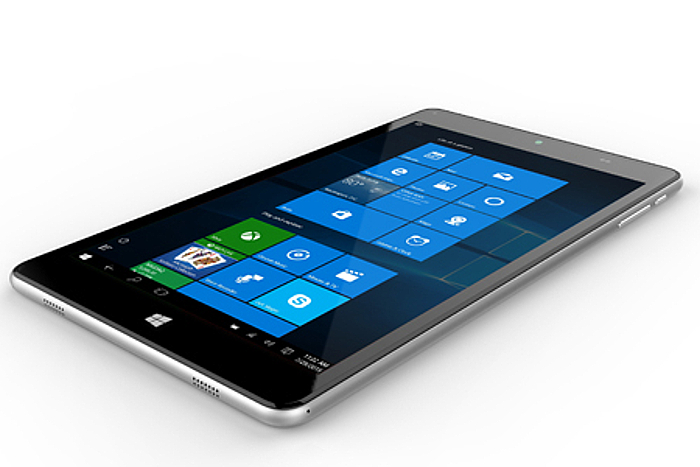
Here are the specs for both:
| NuVision TM800W560L | NuVision TM800W610L | |
| Operating system: | Windows 10 Home (32-Bit) Signature Edition |
Windows 10 Home (32-Bit) Signature Edition |
| Screen size: | 8 inches | 8 inches |
| Panel type: | IPS | IPS |
| Screen resolution: | 1,920 x 1,200 | 1,920 x 1,200 |
| Processor: | Intel Atom Z3735F | Intel Atom x5-Z8300 |
| Processor speed: | 1.33GHz (base) 1.83GHz (boost) |
1.44GHz (base) 1.84GHz (boost) |
| Graphics: | Intel HD Graphics | Intel HD Graphics |
| Graphics speed: | 311MHz (base) 646MHz (boost) |
200MHz (base) 500MHz (boost) |
| System memory: | 2GB DDR3L-RS @ 1,333MHz | 2GB DDR @ 1,600MHz |
| Internal storage: | 32GB | 32GB |
| Cameras: | 2MP front 5MP back |
2MP front 5MP back |
| Connectivity: | Wireless N Bluetooth 4.0 |
Wireless N Bluetooth 4.0 |
| Ports: | 1x Micro USB 1x Micro HDMI 1x Microphone/headphone jack 1x Micro SD slot |
1x Micro USB 1x Micro HDMI 1x headphone jack 2x Microphone input 1x Micro SD slot |
| Battery: | Up to 6 hours | Up to 6 hours |
| Size: | 8.80 x 4.90 x 0.40 inches | 8.30 x 4.90 x 0.30 inches |
| Weight: | 0.68 pounds | 0.60 pounds |
| Color: | Silver | Silver |
| Price: | $129.00 $49.00 | $149.00 $59.00 |
Note that these tablets are based on the “Signature Edition” of Windows 10 Home, meaning customers will find absolutely no bloatware from NuVision on the devices, offering a clean install. Also note that customers who purchase these tablets may need to grab a MicroSD card as well, given that Windows 10 Home will eat up a large portion of the internal storage. The maximum capacity offered by the MicroSD card slot isn’t provided on the product pages.
As for which tablet is a better buy, that’s a good question. The cheaper W560L model has a slightly lower clock speed than the W610L model, but a slightly faster graphics clock speed. The W560L’s memory is slightly slower, too, and it’s not as thin and light as the W610 version. If anything, customers are shelling out an extra $10 for the W610L’s overall lightweight size. Other than that, they’re nearly identical.
If you’re looking for a slightly larger Windows 10 2-in-1 PC, Microsoft is also knocking the price off HP’s x2 10-p092ms with a detachable keyboard. It too offers Windows 10 Home Signature Edition so that customers don’t have to deal with all the resource-hogging, unwanted software OEMs such as HP and Dell like to slap on their PCs. Here are the specs for this model:
| HP x2 10-p092ms | |
| Operating system: | Windows 10 Home (64-Bit) Signature Edition |
| Screen size: | 10.1 inches |
| Panel type: | IPS |
| Screen resolution: | 1,280 x 800 |
| Processor: | Intel Atom x5-Z8350 |
| Processor speed: | 1.44GHz (base) 1.92GHz (boost) |
| Graphics: | Intel HD Graphics 400 |
| Graphics speed: | 200MHz (base) 500MHz (boost) |
| System memory: | 2GB DDR3 @ 1,600MHz |
| Internal storage: | 32GB |
| Cameras: | HP TrueVision HD (front) 5MP (back) |
| Connectivity: | Wireless AC Bluetooth 4.0 |
| Ports: | 1x USB Type-C 1x USB 3,0 1x Mini HDMI 1x Microphone/headphone jack 1x MicroSD card slot |
| Battery: | Up to 9.5 hours |
| Size: | 10.43 x 6.81 x 0.92 inches |
| Weight: | 2.40 pounds |
| Color: | Silver |
| Keyboard: | Included, detachable |
| Price: | $279 $179 |
Of course, if you’re looking for something bigger, now if the time to purchase the following Windows 10 devices before the prices go back up at midnight:
- Dell Inspiron 13 5378 Signature Edition 2-in-1 PC — Starts at $479 (was $749)
- HP Pavilion x360 Convertible 15-bk193ms Signature Edition 2-in-1 PC — $479 (was $729)
- NuVision Duo 10 TM101W635L Signature Edition 2-in-1 PC — $199 (was $299)
- Dell Inspiron 11 i3168-0702BLU Signature Edition 2-in-1 PC — $199 (was $279)


